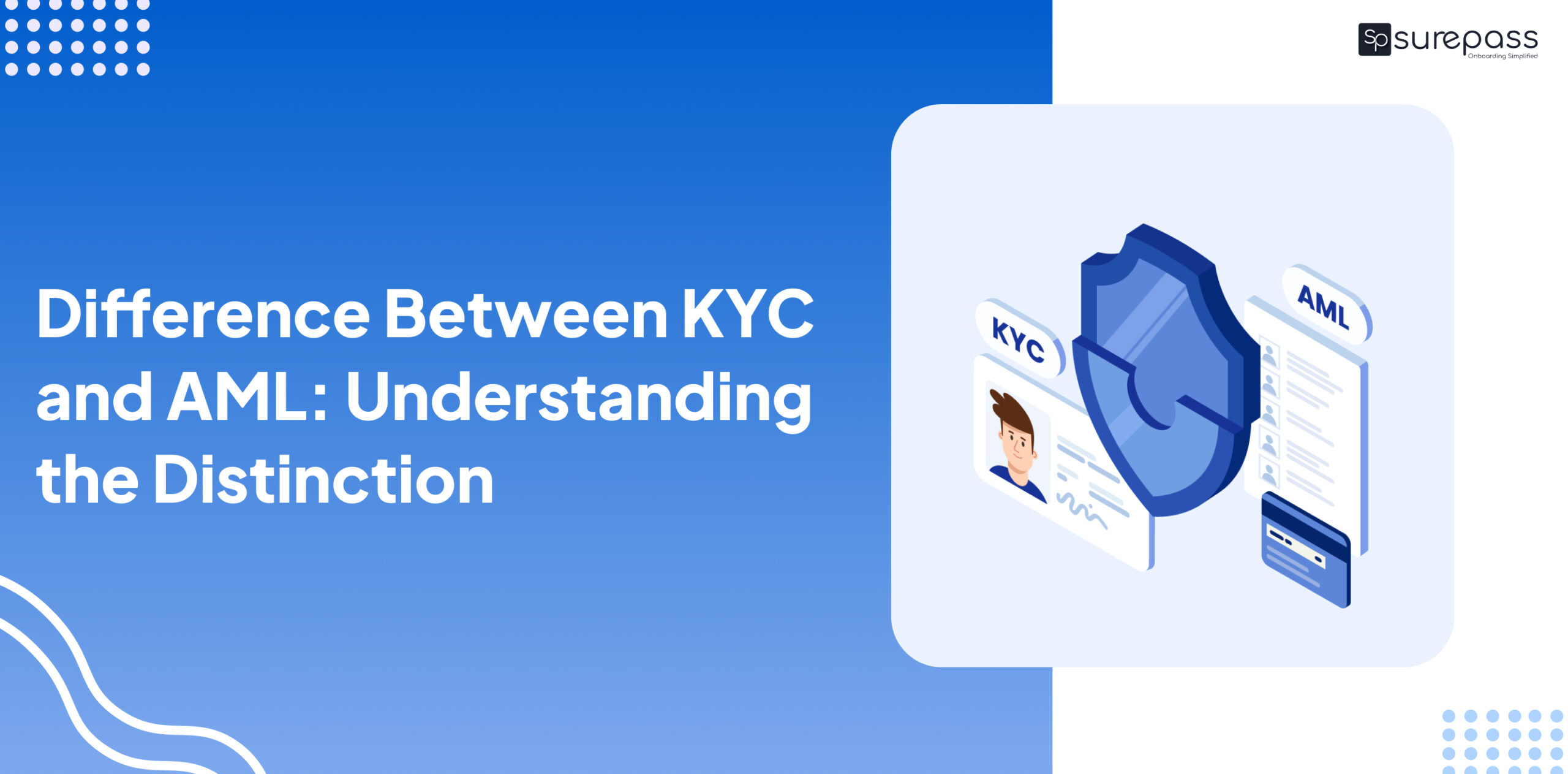Introduction to KYC and AML
In the world of finance, two terms that often come up are KYC and AML. AML KYC’s full form is Know Your Customer (KYC) and Anti-Money Laundering (AML). While they may sound similar, they serve different purposes in the fight against financial crimes. Understanding the distinction between KYC and AML is crucial for financial institutions to ensure compliance and protect themselves from the risks associated with money laundering and fraud.
Understanding KYC (Know Your Customer)
KYC or Know Your Customer is a procedure which financial institutions use to confirm the authenticity of their customers. The primary goal of KYC is to verify customers’ authentic identity and determine their risk potential. Financial institutions can confirm that they’re dealing with legitimate people or entities by collecting relevant data about their customers, such as names and addresses, their dates of birth, as well as identity documents.
The significance of KYC in banks can’t be overemphasized. It’s the first protection against terrorist financing and other financial criminals. With the help of strong KYC procedures financial institutions can reduce the risk of fraud and safeguard themselves from reputational and legal damages.
Key Components of a KYC Process
A comprehensive KYC process typically consists of several key components. These components include customer identification, customer due diligence, risk assessment, and ongoing monitoring. Let’s explore each of these elements in furt:
This step involves verifying the identity of customers by collecting and validating their personal information, such as name, address, date of birth, and identification documents.
- Customer Due Diligence:
Customer due diligence entails conducting a thorough assessment of customers to understand their background, financial activities, and associated risks. This step helps financial institutions identify any red flags or suspicious activities.
- Risk Assessment:
Risk assessment involves evaluating the potential risk posed by each customer. This assessment takes into account factors such as the customer’s occupation, source of funds, and geographic location. Based on the risk assessment, financial institutions can determine the level of due diligence required for each customer.
- Ongoing Monitoring:
Once a customer has been onboarded, financial institutions must continuously monitor their activities for any suspicious transactions or changes in risk profile. Ongoing monitoring enables early detection of potential money laundering or fraudulent activities.
Understanding AML – Anti-Money Laundering and KYC
While KYC concentrates on proving the identity of clients, AML, or Anti-Money Laundering is a more comprehensive system that is aimed at stopping from identifying and stopping money laundering as well as other financial criminal acts. The process of money laundering consists concealing the source of funds obtained illegally and making them appear legitimate. AML measures are intended to detect suspicious transactions that could indicate that there is a money laundering activity.
The importance of AML in combating financial crime can not be overstated. It’s not just about safeguarding financial institutions, but also ensuring your integrity as a financial system in general. Through the implementation of robust AML programs financial institutions are contributing to the overall effort to fight the financing of terrorists, money laundering and other criminal activities.
Key Components of an AML Program
An effective AML program comprises several key components. These components include risk assessment, internal controls, training and awareness, suspicious activity reporting, and regulatory compliance. Let’s analyze each of these parts in more detail:
- Risk Assessment:
Similar to KYC, AML programs begin with a risk assessment to identify and evaluate the potential risks and vulnerabilities faced by a financial institution. This assessment helps determine the appropriate level of AML measures required.
- Internal Controls:
Internal controls refer to the policies, procedures, and systems put in place to prevent and detect money laundering. These controls include transaction monitoring, customer screening against sanction lists, and record-keeping requirements.
- Training and Awareness:
AML programs are only effective if employees are well-trained and aware of their responsibilities. Regular training sessions and awareness programs ensure that employees are equipped with the knowledge and skills necessary to identify and report suspicious activities.
- Suspicious Activity Reporting:
Financial institutions are required to have mechanisms in place for reporting suspicious transactions to the relevant authorities. Suspicious activity reports (SARs) are filed when a transaction or activity raises suspicions of money laundering or other criminal activities.
Regulatory Compliance: Compliance with AML laws and regulations is a vital component of an effective AML program. Financial institutions must stay up to date with the evolving regulatory landscape and ensure that their AML procedures are in line with the requirements set by regulatory bodies.
The Difference Between KYC and AML
Now that we have explored the individual components of KYC and AML, let’s understand the difference between the two. KYC focuses on verifying the identity of customers and assessing their risk level, while AML is a broader framework aimed at preventing money laundering and other financial crimes. In simple terms, KYC is a part of the overall AML process.
KYC is the foundation upon which AML programs are built. It provides financial institutions with the necessary information to assess the legitimacy of customers and detect any potential risks. AML, on the other hand, encompasses a wider range of measures and controls to prevent money laundering and other illicit activities.
The Relationship Between KYC and AML
While KYC and AML serve different purposes, they are closely intertwined. KYC provides the necessary information and customer profile for effective AML measures. A robust KYC process ensures that financial institutions have accurate and up-to-date information about their customers, which facilitates the detection and prevention of money laundering activities.
In essence, KYC enables AML. Without a solid foundation of verified customer information, AML measures would be ineffective. By integrating KYC and AML processes, financial institutions can establish a strong defense against money laundering, terrorist financing, and other financial crimes.
Compliance with KYC and AML regulations is not only a legal requirement but also essential for the reputation and stability of financial institutions. Failure to implement adequate KYC and AML measures can result in severe consequences, including fines, legal penalties, and reputational damage.
Financial institutions must prioritize KYC and AML compliance to ensure that they are not inadvertently facilitating money laundering or other illicit activities. By adhering to the regulatory requirements and implementing best practices, financial institutions can protect themselves and contribute to the overall integrity of the financial system.
Common Challenges In Implementing KYC and AML Measures
Implementing effective KYC and AML measures can be challenging for financial institutions. Some common challenges include:
- Balancing Compliance with Customer Experience: Striking a balance between complying with regulations and providing a seamless customer experience can be a challenge. The KYC process should be efficient and user-friendly to avoid customer frustration.
- Keeping up with Regulatory Changes: To guarantee compliance, financial institutions must be informed on how AML requirements are always changing. Keeping track of regulatory changes and adapting processes accordingly can be time-consuming and resource-intensive.
- Dealing with High Volumes of Data: Financial institutions deal with large volumes of customer data, making it challenging to collect, store, and analyze the information effectively. Implementing robust data management systems is crucial to handle the data effectively.
Ensuring Data Security: KYC and AML processes involve sensitive customer information, and data security is of utmost importance. Financial institutions must have robust security measures in place to protect customer data from unauthorized access or breaches.
Best Practices for Effective KYC and AML Programs
To overcome the challenges associated with implementing KYC and AML measures, financial institutions can adopt the following best practices:
- Implement Risk-Based Approach: Conduct a thorough risk assessment to identify high-risk customers and allocate resources accordingly. A risk-based approach allows financial institutions to focus their efforts on customers with a higher likelihood of involvement in illicit activities.
- Automate Processes: Leverage technology and automation to streamline KYC and AML processes. Automated systems can help in data collection, verification, and ongoing monitoring, reducing manual errors and increasing efficiency.
- Stay Updated with Regulatory Changes: Establish a dedicated team or department to monitor regulatory changes and ensure compliance. Regular training and awareness sessions should be conducted to keep employees informed about the latest regulations and best practices.
Collaborate with Industry Peers: Sharing information and collaborating with other financial institutions can enhance the effectiveness of KYC and AML measures. Industry collaboration can help identify emerging trends, share best practices, and collectively combat financial crimes.
Conclusion: The Need for Robust KYC and AML Frameworks
KYC and AML play critical roles in preventing money laundering, terrorist financing, and other financial crimes. While KYC focuses on customer identification and risk assessment, AML provides a broader framework for detecting and reporting suspicious activities. Financial institutions must implement robust KYC and AML programs to ensure compliance with regulations and protect themselves from legal and reputational risks.
By understanding the distinction between KYC and AML, financial institutions can establish effective measures to combat financial crimes. It is essential to integrate KYC and AML processes, prioritize compliance, and stay updated with regulatory changes. With a strong KYC and AML framework in place, financial institutions contribute to the overall integrity and stability of the financial system.





